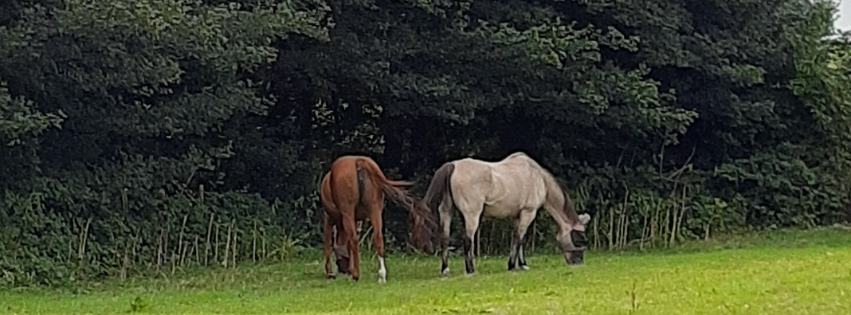Why sweet itch isn’t just an allergy
The real root cause, and why managing the gut, liver, and kidneys holds the key
Image: Nothing posed here - our MacAttack in real world sweet itch on a wet muddy summer day, 2022
If you’ve ever owned a horse with sweet itch, you’ll know – it’s more than just an itch.
It's truly the worst of all skin torments. The relentless rubbing, raw patches and open wounds, mane and tail wreckage – it’s enough to drive any horse (and owner) to distraction. And I speak from experience, having cared for two chronic sweet itch sufferers – our Kelso and MacAttack.
For years, sweet itch was chalked up as a hypersensitivity to midge saliva – a classic allergic reaction. Yes, midge bites play a role, but today we understand that the immune reaction is just the tip of the iceberg.
We now know that sweet itch stems from a much deeper dysfunction – a metabolic condition known as Cryptopyrroluria (KPU). If you’re not familiar with it, KPU is a multi-metabolic detoxification disorder that disrupts the gut-liver-kidney axis. We’ve got a full page on it over on the website – link below.
🌿 Enter KPU: The root behind the itch
At EquiNatural we’ve seen time and again that sweet itch is one of the clearest manifestations of KPU – a multi-system detox dysfunction rooted in a disturbed hindgut biome.
A Gut-Liver-Kidney Metabolic Traffic Jam
A massively disturbed hindgut biome triggers inflammation in the intestines. This sets off a hyperactive immune reaction to various environmental triggers – in this case, midge bites – triggering a rush of allergen-related toxins. The immune system floods the body with histamine and other anti-allergy compounds, and the liver – which should detox these – becomes overwhelmed by the toxic flood.
The liver calls for backup – which means the kidneys are next in line. But when the toxin queue gets too long? The kidneys pass the baton to the skin as an emergency detox route.
And that’s where the trouble really begins.
The skin, now forced into being the body’s primary detox organ, starts excreting inflammatory substances through the sweat glands and skin fats, which in turn induces intense itching.
We know fly rugs help – fewer bites, fewer symptoms. But in many cases, even in winter, some horses still scratch. Why? Because the problem isn’t just the midges. It’s the internal pressure cooker pushing those toxins out through an exit route they shouldn’t be using.
NB. We also see this pattern in Mallenders/Sallenders, which share the same underlying imbalance of gut, liver, and kidney function. (Spoiler alert – we’ll be talking about this in June with a nod in our June Sale.)
The only real way forward? Address the gut-liver-kidney axis with a targeted regeneration programme – just as we do in our KPU protocol.
Straight from the Expert – A Deep Dive with Dr Christina Fritz
In a training case study I attended a few months back with equine health expert Dr Christina Fritz, the sweet itch puzzle was laid out in forensic detail. Bottom line? Sweet itch = KPU.
The early life gut connection
KPU often starts early – even from birth. If a foal’s dam doesn’t have a healthy gut microbiome, the foal may struggle to establish one too – especially since a foal’s first biome is largely inherited by eating their dam’s faeces. But even more disruptive is the widespread use of antibiotics in early life.
When a foal develops a serious infection, the choice is often stark – antibiotics or euthanasia. Of course we choose antibiotics. But it’s crucial to understand that this life-saving intervention can permanently alter the gut’s development.
Antibiotics block the establishment of the foal’s foundational gut biome — the wall-bound microbial community that supports metabolic health for life. Even with perfect care later on, these horses often remain metabolically fragile, struggling with KPU symptoms and never fully recovering gut integrity.
When biotransformation breaks down
The liver doesn’t detox per se – it transforms toxins so the kidneys can eliminate them. In KPU, this biotransformation process has been disrupted (driven by that disturbed hindgut biome), leaving fat-soluble waste to build up.
Normally, the liver converts fat-soluble toxins into water-soluble forms that the kidneys can excrete. But in KPU horses, this process is impaired – so the toxins get stored in fat tissue or excreted via the skin.
Two types of itchy horses
Dr Fritz explained that there are actually two kinds of itchy horses, both tied to systemic overload:
- Classic Sweet Itch: Rubs mane, tail, back, and belly.
- Pseudo Sweet Itch: Scratches neck, chest, flanks – often where they sweat most.
The pseudo cases are often kidney-driven. Sweat glands work with the kidneys to excrete water-soluble toxins, but when these toxins are highly acidic, they irritate the skin – much like vinegar on a scratch.
Classic sweet itch cases, meanwhile, seem to involve fat-soluble toxins. Some breeds have more skin fat glands along the midline, which becomes the route of excretion. Another reason to need feed liquid oils into the feedbowl - you’ll directly see the effects on the skin.
The skin always mirrors the soul
Add in trauma (especially in imported horses) and emotional stress can tip the system further out of balance. Dr Fritz always recommends trauma support alongside gut-liver-kidney care.
So, what helps?
First: Don’t just treat the skin. Treat the systems.
A true sweet itch plan needs to:
- Stabilise the gut microbiome:
- our KPUCOMBO (gut stabilier stage of our KPU Reset Programme)
- Support liver transformation function:
- P5P (initially blended into our KPUCOMBO for the first month then fed independently. Also available on subscription to help keep cost down)
- Relieve pressure from the kidneys
- LKLCARE (second stage of our KPU Reset Programme - tonifies the liver:kidneys:lymphatics)
- Consider emotional trauma as part of the picture
- optional StressTonic
Equally, herbs such as those in our SwItchTonic play a vital role in lessening the itch and supporting this drainage pathway, but for long-term resilience? A full KPU regeneration programme will be the most effective route forward.
Final thoughts
Sweet itch might look like a skin problem, but the skin is just the messenger.
Behind the scenes, a complex interplay between the gut, liver, and kidneys is crying out for balance. With the right tools – diet, appropriate phytonutrients, lifestyle, emotional care – we can gently guide the body back to better function, one layer at a time.
I was too late to truly help Kelso other than manage his symptoms, but MacAttack got the benefit of the KPU research. 15-months later he was a reformed boy, so much so that he became just Mac, and we never looked back 😉
KPU therapy reveals a gradual improvement over three years:
- Year 1: Scratching persists, but you may see slight improvement.
- Year 2: Onset is later, and scratching is less intense.
- Much less intense for Mac
- Year 3: The itch often resolves entirely.
- Mac still gives his bum an occasional rub on a tree, but nothing like the intensity of his previous self, and never hard enough to break the skin. NB - we have religiously kept him on MetaTonic and SwItchTonic from spring till early winter, with an LKLCARE at every coat change. He also gets BiomeTonic to keep his gut function steady.
Above all, consistency is key. Maintain a healthy diet and microbiome, and avoid triggers like haylage which can rapidly undo any progress.
Sweet itch is frustrating and complex, but not hopeless. With today’s knowledge, a healthy dollop of long-term patience, and a whole-horse approach, sweet itch can be reversed, but you need to be in it for the long-haul.
👉 Explore our full KPU page here.
.










